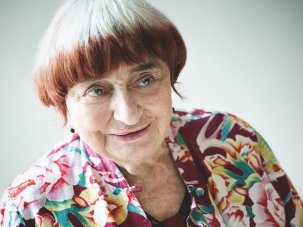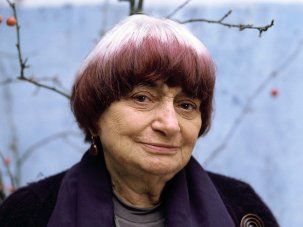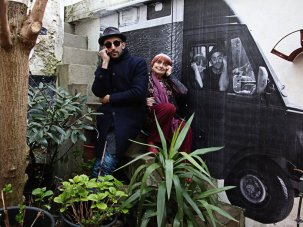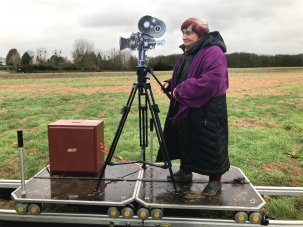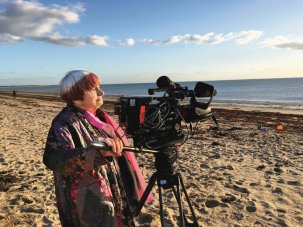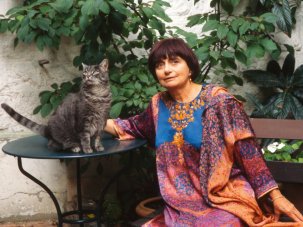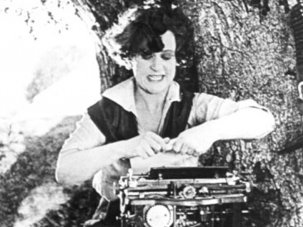Web exclusive
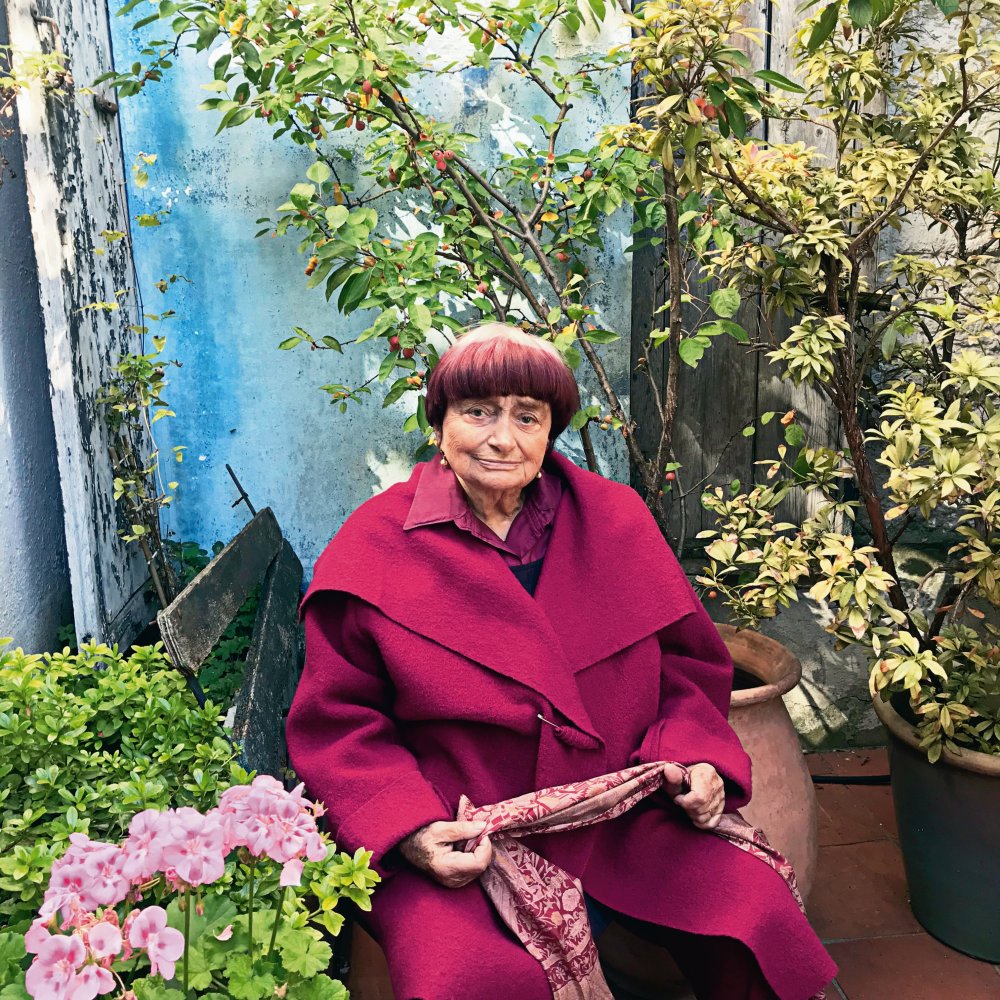
Agnès Varda posing in Varda by Agnès
Unless they are animators (or landscape specialists, such as James Benning), filmmakers usually devote the bulk of their energies to casting, framing and guiding actors. But to what extent is directing also a performance, a ‘role’ in the theatrical sense?
Varda by Agnès is released by the BFI in UK cinemas from 19 July 2019 and is reviewed in the August 2019 issue of Sight & Sound.
Many directors have felt the need to turn their own metier into a kind of performance art, creating personas which define them in the public eye. Alfred Hitchcock, whose appearances in trailers and as host of his television series presented what Tag Gallagher (citing Hitchcock’s Irish ancestry) has described as an Irishman’s parody of an English gentleman, is perhaps the most famous example, though the monocled riding crop-wielding tyrant in jodhpurs incarnated by Erich von Stroheim was long seen as the stereotype of the perfectionist auteur. More recent instances tend to be subtler, though perhaps not that much subtler: Werner Herzog meticulously cultivates his image as an uncompromising adventurer whose distinctive speech pattens suggest a barely concealed contempt not merely for the things he is talking about, but even for the very words he is using – hardly surprising that he should have been cast as a James Bond-style villain in Jack Reacher (2012).
The late Agnès Varda nurtured a notably elusive facade, oddly so, since on the surface her public persona – playful, curious, accessible – could hardly be more straightforward. Yet, as the comments with which she introduces The Beaches of Agnès (Les plages d’Agnès, 2008) imply, this persona is at least partly performative: “I’m playing the role of a little old lady, pleasantly plump and talkative, telling her life story.”
The difficulty of grasping exactly what Varda is (and isn’t) allowing us to see might be referred to the various ways in which she defines first-person filmmaking. Broadly speaking, her oeuvre can by divided into three categories:
- Fiction films in which there is no obvious element of autobiography: La Pointe-Courte (1954), Cléo from 5 to 7 (Cléo de 5 à 7, 1961), Le bonheur (1965), One Sings, the Other Doesn’t (L’une chante, l’autre pas, 1976), Vagabond (Sans toit ni loi, 1985).
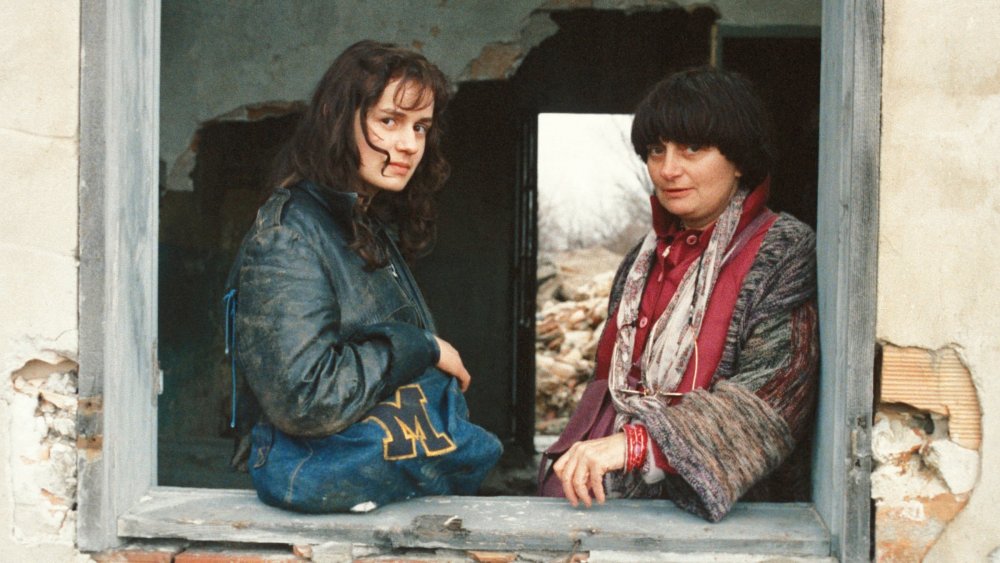
Sandrine Bonnaire and Agnès Varda on the location of Vagabond
- Fiction films in which the lead actress is an obvious stand-in for Varda: Shirley Clarke in Lions Love (aka Lions Love… and Lies, 1969), France Dougnac in Nausicaa (1970), Sabine Mamou in Documenteur (1981).
- Documentary portraits focusing on Varda’s relationships with a star/subject – Uncle Yanco (1967), Jane B. par Agnes V. (1987) – a collaborator – Faces Places (Visages villages, 2017) – or a larger group – The Gleaners and I (Les glaneurs et la glaneuse, 2000), The Beaches of Agnès.
Yet these distinctions are constantly being challenged by the actual texts. Although there is no overtly autobiographical element, Varda surely identifies with the protagonists of Cléo from 5 to 7 and One Sings, the Other Doesn’t (in which the daughter of one of the central characters is played as an adult by the director’s daughter Rosalie), while La Pointe-Courte was shot in the area where she lived during the German occupation.
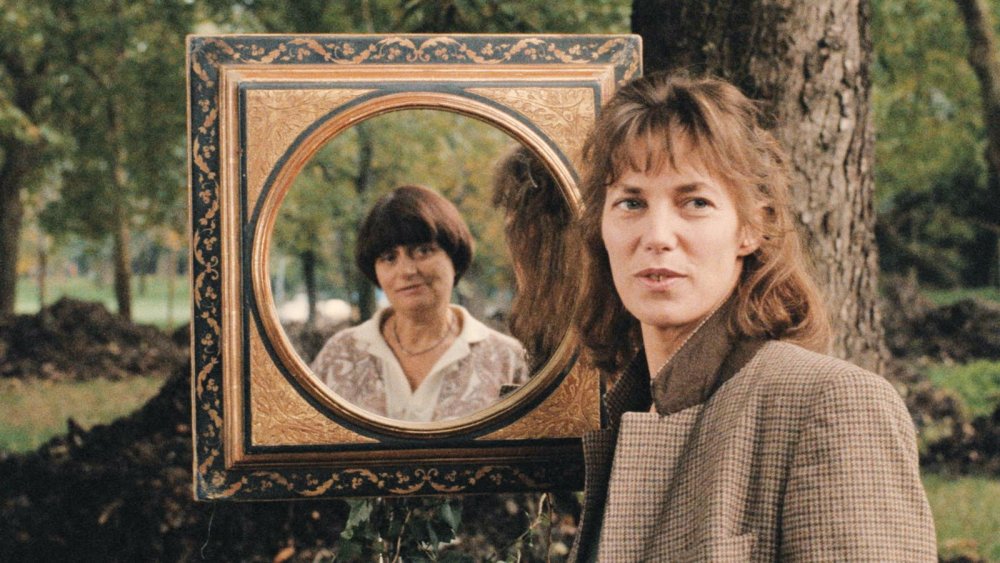
Jane Birkin and Agnès Varda in Jane B. par Agnès V.
Even the subjects of her documentaries function to some extent as stand-ins for (or at least extensions of) Varda; the gleaners in The Gleaners and I are particularly relevant, in that Varda links their insistence on gathering discarded food with her own artistic practices (in The Gleaners and I… Two Years Later (2002), she defends the earlier work’s autobiographical aspects by insisting “I glean, too. I glean images for my film”). As she tells Jane Birkin in Jane B. par Agnes V., “I’m filming your self-portrait. But you won’t be alone in the mirror. There’ll be the camera, which is a bit me. Never mind if I appear in the mirror or the background.”
Several films function as companion pieces to works that belong in other categories: Documenteur is related to (and in one sense about the making of) the documentary Mur murs (1980), while Jane B. par Agnes V. outlines the genesis of Varda’s ‘fiction’ feature Kung-Fu Master! (1987). One Sings, the Other Doesn’t actually pauses to advertise its ‘complement de programme’, The Pleasure of Love in Iran (Plaisir d’amour en Iran, 1976), preceding this promotional gesture with a shot of Darius (Ali Rafie) and Pauline (Valérie Mairesse) walking away from a mosque while Pauline observes in voiceover that “Once in Iran, I immediately felt I’d become a postcard myself, or an extra in a short subject.” This mosque image reappears at the end of the ‘short subject’ as narrator Thérèse Liotard insists Iran is “an unsettling place for any lovers, even if they are characters in a film”.
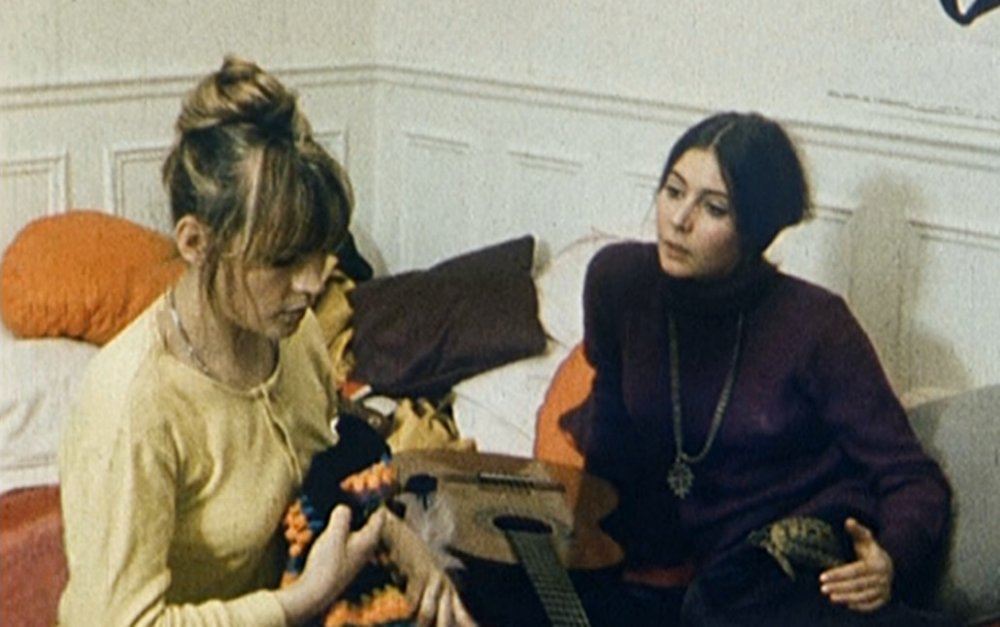
France Dougnac as Agnès and Myriam Boyer as Rosalie in Nausicaa
And then there’s Nausicaa, an uncategorisable work about Greek exiles commissioned, and subsequently shelved, by French television’s ORTF channel. Only extant in work-print form, Nausicaa intercuts dramatised sequences in which France Dougnac plays ‘Agnès’ with documentary sections where Varda appears as herself. Varda here interrogates both her own myth-making (“Is it still mythology or already reality?”) and the means of production, explaining that a conversation with some Greek sailors encountered during the shoot is seen but not heard because union regulations meant no sound engineer could be present: “Why? Might as well ask ORTF how long a piece of string is!”
Even films which can be neatly categorised as nonfiction contain obviously ‘staged’ moments: the director’s conversations with Birkin in Jane B. par Agnes V. and J.R. in Faces Places have evidently been rehearsed and, to some extent, scripted. As Varda observes in her short Ydessa, the Bears and etc. (Ydessa, les ours et etc…, 2004), “You soon feel that reality is sliding away and splitting in two, leading us towards fiction, to a screenplay.” And while most documentaries include fabricated elements, what’s notable about Varda’s interventions in the form is her refusal to be a ‘documenteur’ (a word combining ‘documentary’ with ‘liar’), to disguise her preplanning and use ‘naturalistic’ techniques to convince us that what we are seeing occurred spontaneously before the camera (obvious examples would be the multiple takes of Varda greeting Uncle Yanco, and the closing scene of Faces Places in which J.R. finally removes his dark glasses, an event seen from Varda’s perspective as a blur).
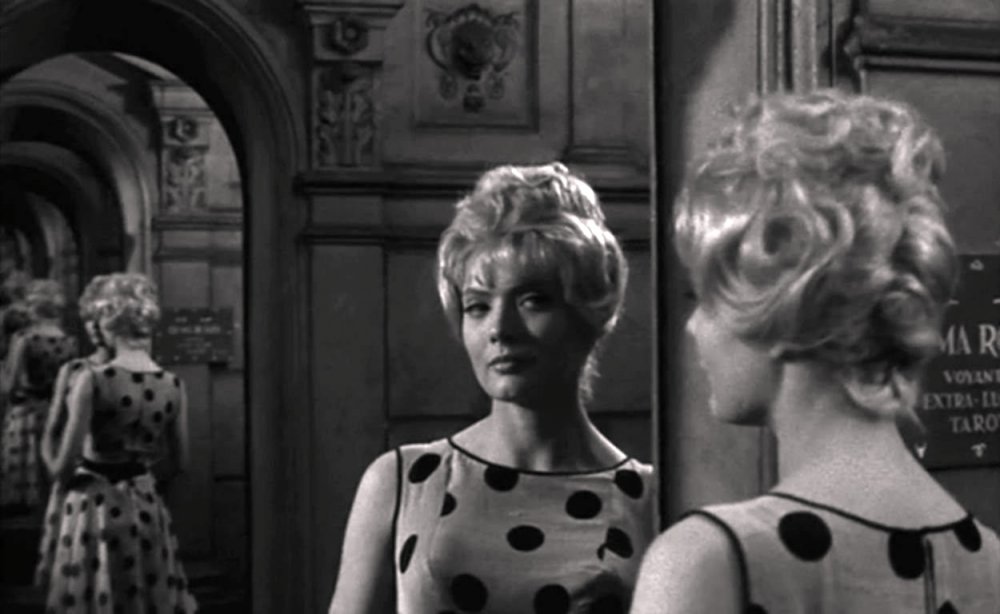
Corinne Marchand as Cléo in Cléo from 5 to 7
Similarly, what appear to be ‘smooth’ works of fiction contain moments where ‘rough’ reality is allowed to intrude – or rather where the barrier between these two opposed modes starts to dissolve. Many of the ‘actors’ in Vagabond (notably the philosophy teacher turned goat farmer) are essentially playing themselves, as is the lawyer Gisèle Halimi in One Sings, the Other Doesn’t, while Cleo (Corinne Marchand)’s ambivalent relationship to fame in Cléo from 5 to 7 (Varda once described this character as someone who “defines herself through the visions of others”) is reinforced by images of pedestrians staring at her – though what they are fascinated by is clearly the spectacle of a film being shot.
This juxtaposition of reportage and drama was already present in Varda’s debut, La Pointe-Courte, where modern alienation/fiction and traditional community/documentary are less opposed terms than variations on the same dilemma. Similar concerns are evident in Diary of a Pregnant Woman (L’opéra-mouffe, 1958), which views realism and surrealism as two sides of the same coin, Le bonheur, whose ‘fictional’ family is portrayed by four members of a ‘real’ family, reinforcing our sense of intolerable truths constantly threatening to break through a false surface, and Les creatures (1966), where the relationship between reality and myth, creator and creation, is depicted in purely negative terms.
~
Lions Love is where all the boundaries break down, making it impossible to say if what we are watching is fact or fabrication, a portrait of Shirley Clarke or a slice of autobiography. Shot soon after Varda’s attempt to make a feature for Columbia had been abandoned as a result of the studio’s refusal to grant her final cut, Lions Love casts Clarke as an auteur who arrives in Los Angeles at the invitation of a studio wishing to hire her, a project which falls apart when executives insist on retaining the right to final cut.
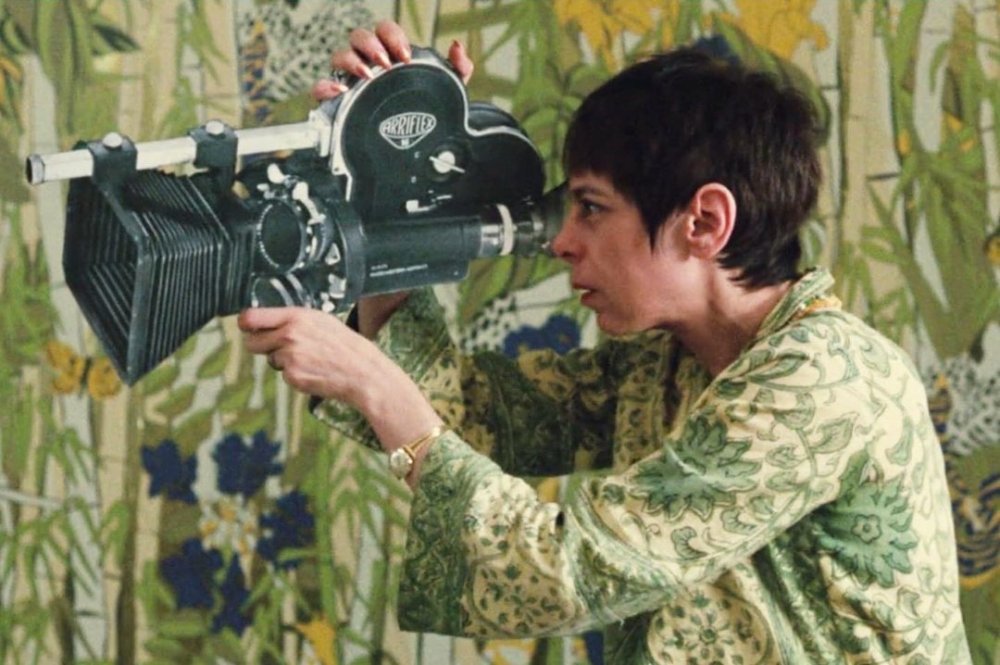
Shirley Clarke in Lions Love
Complicating the echoes of Varda’s situation is the fact that Clarke is playing herself. And although Clarke’s struggle to work in Hollywood is entirely fictional, she interacts with both real people (Viva, James Rado, Gerome Ragni, Eddie Constantine, Carlos Clarens) and real situations: Lions Love takes place during the course of a few days in 1968 when Robert Kennedy was assassinated and Andy Warhol shot by Valerie Solanas. Onscreen characters react to television and news reports of these events as if they were taking place before their very eyes, though the filming occurred some months later. Lions Love foregrounds the process by which identity is created ‘after the fact’, brought into being through a process of more or less conscious planning. As Clarke observes, “I’m getting so I don’t know the difference, whether I’m in a movie or making a movie… Which comes first, the movie or reality?”
The key moment has Clarke unable to continue with a scene in which she is trying to commit suicide. Addressing the camera, she says “I’m sorry, I just can’t do it, Agnès. I’m not an actress.” As Clarke continues to protest (“It’s your story. You do it”), an evidently annoyed Varda takes her place on camera, demonstrating how the suicide should be played.
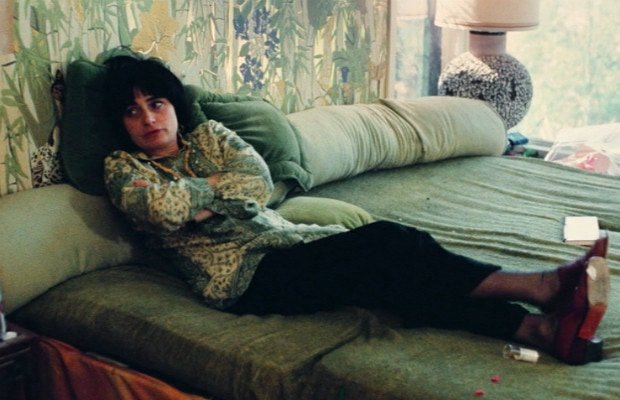
Agnès Varda in Lions Love
But is what we are watching a ‘genuine’ argument Varda chose to retain, or a scripted scene? We have no way of knowing, just as we have no way of knowing to what extent the self-consciously theatrical poses struck by Viva, Rado and Ragni conceal or reveal inner truths; as Ragni remarks while watching a televised speech by Robert Kennedy, “He isn’t acting. He really means it.”
Varda’s point is that it is possible to both ‘act’ and ‘really mean it’. Indeed, Lions Love’s status as a work of fiction is entirely theoretical, since it could just as easily be categorised as a documentary about its stars. Attempts to avoid public exposure, to create a private world in which the ‘true’ self can be expressed in pure form, might themselves be forms of self-promotion, an idea neatly suggested by a shot of Peter Bogdanovich hiding his face from the camera by holding up a book – which happens to be his own book on John Ford.
Which brings us back to Varda’s directorial persona, one that may seem more playful, less ‘serious’, than Werner Herzog’s, with its masculine emphasis on merely physical risk, but actually goes much deeper. For what is at risk with Varda is identity itself, something that is in danger of being lost in an endless hall of mirrors at the end of which lies only obliteration.

Agnès Varda in The Beaches of Agnès
This existential precariousness is front and centre in her magnificent final feature, Varda by Agnès (2019), which initially appears to be a record of a lecture given by the director in an opera house. But while the lecture itself is essentially seamless, its location proves to be in a state of constant flux, taking in a cinema, an outdoor auditorium, a field, a beach, etc. Not only that, but parts of the lecture consist of clips from various documentaries, essay films and DVD extras Varda has created over the years. The idea of identity as something immutably ‘fixed’ is here replaced by a fluid puzzle formed of diverse settings, ages, hairstyles, outfits and screen ratios. The ending, in which Varda, like Prospero, brings down the curtain on her oeuvre, has the director vanishing into a sandstorm, a conclusion that seems almost inevitable.
Mortality has been central to Varda since Cléo, which, like Vagabond, begins with its heroine being pronounced dead. Jacquot de Nantes (1991) moves constantly between life and art, documentary and dramatisation, technique and inspiration, doing and watching, black and white and colour, concerns which never neatly align, but are eventually subsumed into a portrait of the dying Jacques Demy.
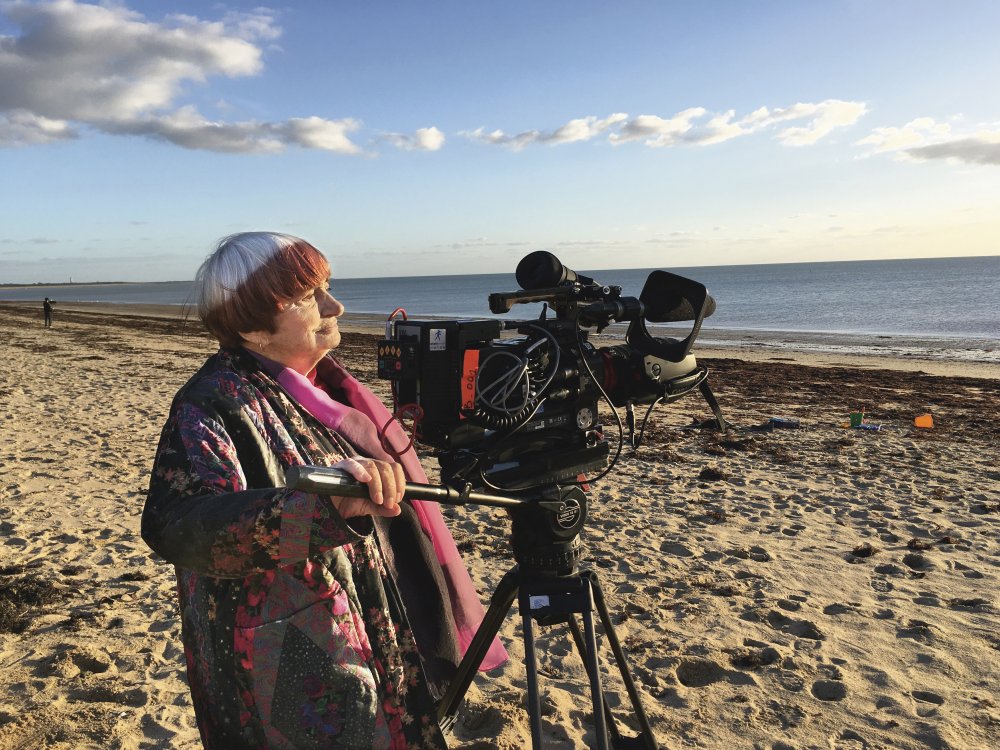
Agnès Varda in Varda by Agnès
Varda’s own mortality is directly confronted from at least the time of The Gleaners (in which she films the liver spots on her hands), the theme becoming increasingly prominent in her final works: the skull imagery that winds up the five-part television series Agnes Varda: From Here to There (Agnès de ci de là Varda, 2011), the video of her cat’s tomb in Varda by Agnès (“Seen from further away, she was like any human, minuscule in the universe”), the miniature cemetery in Faces Places. The latter film is relentlessly focused on eyes and the process of vision, yet marked by an awareness that its creator is approaching a point where vision will be erased (her collaborator stresses the need to “get as many images as we can before it’s too late”).
This is the inescapable fact lurking behind all fiction, the reality that cannot be avoided by adopting a stylish persona. As Clarke’s refused suicide in Lions Love suggests, performance is always connected with death. In this context, it is worth recalling Jane B. par Agnes V., during which Varda discusses ‘The Unknown Woman of the Seine’, an unidentified corpse whose death mask was widely reproduced. Speculating upon the possibility that this woman’s smile was created by an undertaker, Varda wonders if the death mask might be “the only true portrait”.
-
The Digital Edition and Archive quick link
Log in here to your digital edition and archive subscription, take a look at the packages on offer and buy a subscription.




